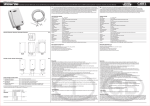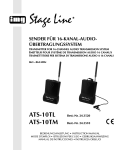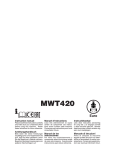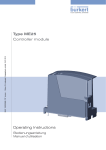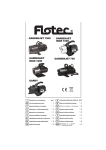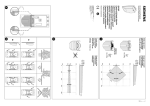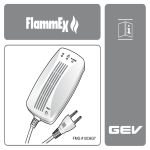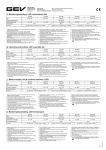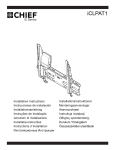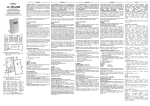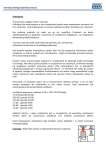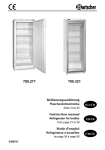Download Istruzioni per uso
Transcript
Max. 14 Ct./Min aus dem deutschen Festnetz. Mobil max. 42 Ct./Min. International calls may vary. 000926 MA00432602 GEV GmbH Heidehofweg 16 25499 Tangstedt Germany www.gev.de [email protected] Hotline: +49 (0)180/59 58 555 11/2014 UW www.gev.de Typ: LBM 926 # 000926 C F D H 10 m A 1m 1 B E2 E1 1212 V V12 V 1212 V V12 V I G Power Power Power 1 2 2 3 90° 120° 90° Beachten Sie die maximal Lasten! 4 Anschluss Beispiele: Abb. E1 = Extern gespeiste Klingel Abb. E2 = Leuchte mit gleicher Spannung wie der Bewegungsmelder LBM. Verbinden Sie die Kabel mit der Anschlussleitung gemäß Schaltbild (Abb. E). und setzen den Bewegungsmelder auf die Wandanschlussplatte Abb. F. Schalten Sie die Stromkreissicherung wieder ein. Reichweitentest Stellen Sie den Regler TIME auf Minimum, den Regler LUX auf „Sonne“ und den Regler METER auf Maximum (Abb. G). Falls der Bewegungsmelder über einen separaten Schalter angeschlossen ist, schalten Sie ihn ein. Es beginnt ein 15 Sek. andauernder Selbsttest. In dieser Zeit ist der angeschlossene Verbraucher dauernd eingeschaltet. Wenn sich der Verbraucher ausschaltet, beginnt der Reichweitentest. Der Verbraucher schaltet sich jetzt unabhängig von der Umgebungshelligkeit bei jeder Bewegung für ca. 5 Sek. an. Diese Zeit beginnt bei jeder Bewegung von vorne. Dieser Reichweitentest hilft Ihnen, den Erfassungsbereich zu ermitteln. Der Bewegungsmelder lässt sich horizontal (Abb. I) und DE Recycling-Hinweise Dieses Gerät darf nicht mit dem unsortierten Hausmüll entsorgt werden. Besitzer von Altgeräten sind gesetzlich dazu verpflichtet, dieses Gerät fachgerecht zu entsorgen. Informationen erhalten Sie von Ihrer Stadt- bzw. Gemeindeverwaltung. GB vertikal (Abb. H) ausrichten. Mit dem Regler METER können Sie zusätzlich die Reichweite einstellen. Nach erfolgreicher Einstellung können Sie weitere Einstellungen vornehmen. Einstellungen (Abb. G) LUX Dämmerungsschalter ca. 5 bis 1000 Lux. TIME Zeiteinstellung für die Einschaltdauer ca. 5 Sek.- 15 Min. Störung Bewegungsmelder schaltet zu spät Maximale Reichweite wird nicht erreicht Bewegungsmelder schaltet ständig oder unerwünschtes Schalten Keine Reaktion bei Fahrzeugen Ursache •Einstellung Erfassungsbereich •Bewegung frontal •Bewegungsmelder zu niedrig angebracht •Temperaturdifferenz von Umgebung zur Wärmequelle ist zu gering •Ständige Wärmebewegungen: In den Erfassungsbereich fallen Bereiche, die nicht erfasst werden sollen, wie z. B. Gehwege, Straßen, Bäume reflektierendes Wasser u.s.w. Unerwartete Veränderungen von Wärmequellen durch Sturm, Regen oder Ventilatoren. Beeinflussung durch Sonneneinstrahlung direkt/indirekt •Fahrzeug nicht warmgefahren •Motorbereich ist stark isoliert Abhilfe •Erfassungsbereich durch Drehen des Sensors einstellen •Höher montieren •Bewegungsmelder neu Ausrichten, ggf. •Montage Ort ändern Technische Daten Erfassungsbereich120° Zeiteinstellung ca. 5 Sek. - 15 Min. stufenlos einstellbar Reichweite ca. 1 m bis ca. 10 m abhängig von der Montagehöhe und Außentemperatur Dämmerungsschalter ca. 5 - 1000 Lux stufenlos einstellbar Schaltleistung potenzialfreies Relais 10 A, 12 V bis 30 V Spannungsanschluss 12 V Schutzart IP 44 Empfohlene Montagehöhe ca. 2,5 m Abmessungen ca. B 100 x H 80 x T 117 mm Technische und optische Änderungen ohne Ankündigung vorbehalten. 5 FR Fehleranalyse – Praktische Tipps IT Installation Der Bewegungsmelder LBM kann sowohl an Wände als auch an Decken montiert werde (Abb. A). Je nach Montageart und Einstellbereich eines der vorgestanzten Löcher ausbrechen (Abb. B1 oder Abb. B2). Führen Sie die Kabel und das Gewinde des Bewegungsmelderkopfes in das Loch und befestigen diese mittels Unterlegscheibe und Mutter (Abb. C). Führen Sie das Anschlusskabel durch die Gummi Tülle Abb. D1 und montieren die Wandanschlussplatte gemäß Abb. D. Der Bewegungsmelder LBM verfügt über ein potentialfreies Relais, zur Schaltung von Leuchten oder anderen Geräten. PL Bewegungsmelder 12 Volt LBM 926, 120° Arbeitsweise Der Bewegungsmelder arbeitet nach dem Prinzip der PassivInfrarot-Technik. Über einen PIR-Sensor nimmt der Bewegungsmelder in seinem Erfassungsbereich sich bewegende Wärmequellen wahr und schaltet die angeschlossenen Verbraucher automatisch ein. Ruhende Wärmequellen schalten den Bewegungsmelder nicht ein. Der einstellbare Dämmerungsschalter sorgt dafür, dass der Bewegungsmelder wahlweise bei Tag und Nacht oder nur bei Dunkelheit arbeitet. Mit dem eingebauten Timer wird die Einschaltdauer des angeschlossenen Verbrauchers eingestellt. Sicherheitshinweise Die Montage darf nur von einem Fachmann unter Berücksichtigung der landesüblichen Installationsvorschriften ausgeführt werden. Es darf nur in spannungsfreiem Zustand gearbeitet werden, dazu unbedingt die Stromkreissicherung abschalten. Überprüfen Sie, ob die Anschlussleitung spannungsfrei ist! Bei Schäden, die durch Nichtbeachtung dieser Bedienungsanleitung verursacht werden, erlischt der Garantieanspruch! Für Folgeschäden übernehmen wir keine Haftung! Bei Sach- oder Personenschäden, die durch unsachgemäße Handhabung oder Nichtbeachtung der Sicherheitshinweise verursacht werden, übernehmen wir keine Haftung. In solchen Fällen erlischt jeder Garantieanspruch. Aus Sicherheits- und Zulassungsgründen ist das eigenmächtige Umbauen und/oder Verändern des Gerätes nicht gestattet. Montageort Die sicherste Bewegungserfassung wird erzielt, wenn man sich quer zum Bewegungsmelder bewegt. Daher sollte ein Bewegungsmelder immer so montiert werden, dass man sich nicht direkt auf ihn zu bewegt. Connection: Examples Fig. E1 = Externally powered doorbell Fig. E2 = Lights with the same voltage as the LBM motion detector. Connect the cable to the power supply line according to the circuit diagram (Fig. E) and place the detector on the wall connection plate Fig. F. Switch the circuit protection back on. Range test Set the TIME controller to minimum, the LUX controller to “sun” and the METER controller to maximum (fig. G). If the detector is switched on via a separate switch, turn this on. A self-test is then initiated lasting approx. 15 seconds. The connected device will remain on throughout this time. When the device turns off, the range test will begin. The device will now switch on for approx. 5 seconds in response to any movement, regardless of the ambient lighting level. This time period is initiated by any movement from the front. This range test is designed to help you to determine the field of detection. The motion detector can be adjusted horizontally (fig. I) and vertically (fig. H). The METER controller also allows you to set the range. Once this has been adjusted successfully you will be able to make further settings. Settings (fig. G) LUX Twilight switch approx. 5 to 1000 lux TIME Time setting for the ON period approx. 5 sec. – 15 min. 6 Troubleshooting – Practical tips Problem Cause Remedy Motion detector switches • Detection range setting • Adjust detection area by the light on too late • Movement from the front turning the sensor Motion detector fails to • Motion detector is mounted too low • Mount higher achieve maximum range • Difference in temperature between heat source and surroundings is not big enough Motion detector switches • Constant warm movement: • Re-align detector and, if necessary, light on constantly The field of detection encompasses areas change its location or when not necessary that do not require monitoring, such as pathways, roads, trees and reflective water. Unexpected change in heat sources due to a storm, rain or fans. Influence of direct/indirect sunlight Fails to react to vehicles • Vehicle has not warmed up • Engine area is very well insulated Technical data Field of detection120° Time adjustment approx. 5 sec. - 15 min., infinitely variable Range approx. 1 m to approx. 10 m depending on installation height and outside temperature Twilight switch approx. 5 - 1000 lux, infinitely variable Switching capacity floating relais 10 A, 12 V to 30 V Power supply connections 12 V Protection type IP 44 Recommended installation height approx. 2.5 m Dimension approx. H 100 x W 80 x D 117 mm Subject to technical and design changes without prior notice. 7 DE GB contain substances which are harmful to the environment and to human health and must therefore be disposed of correctly. FR Check maximum loads! Recycling instructions Used batteries must not be disposed of as unsorted household waste. Used batteries must be recycled and may be returned free-of-charge to the place of sale. Batteries IT (fig. B1 or fig. B2). Guide the cable and the thread of the detector head into the hole and secure using a washer and nut (fig. C). Guide the connecting cable through the rubber grommet fig. D1 and mount the wall connection plate according to fig. D. The LBM motion detector has a floating relay for switching lights or other devices. Operation The motion detector operates using passive infrared technology. Via a PIR sensor, the detector notices any heat sources moving within its field of detection and switches on automatically. Static heat sources do not trigger it. The adjustable twilight switch lets you choose whether you have the motion detector working day and night or only when it is dark. The integrated timer also lets you adjust how long the light stays on. Safety information To be fitted by qualified electricians only, observing all standard national installation regulations. No work to be carried out while live. The circuit trip switch must therefore be switched off. Check to make sure the connecting cable is not live! All warranty claims will be null and void in the event of any damage or loss caused by failure to observe these operating instructions. We accept no liability for any consequential losses or damage. We accept no liability for any personal injury or material damage caused by improper use or by failure to observe the safety advice. In such cases all warranty claims will be null and void. For reasons of safety and approval, no unauthorised conversion and/or modification of the appliance is allowed. Where to install The motion detector is at its most effective when approached diagonally. Motion detectors should therefore always be set up so that they are not directly approached. Installation The LBM motion detector can be mounted either on a wall or on a ceiling (fig. A). Unplug one of the pre-punched holes that is most suitable for the type of installation and the programmable range PL Motion detector 12 volt LBM 926, 120° Veillez à respecter la charge maximale ! Alimentation : Exemples Fig. E1 = sonnette à alimentation externe Fig. E2=luminaire avec une tension identique au détecteur de mouvement LBM. Raccordez les câbles conformément au schéma électrique (fig. E), puis positionnez le détecteur de mouvement sur l‘embase de raccordement murale (fig. F). Remettez en place le fusible secteur. Test de la portée Positionnez la molette TIME sur minimum, la molette LUX sur le symbole „soleil“ et la molette METER sur maximum (fig. G). Si le détecteur de mouvement est raccordé à un interrupteur, assurez-vous que celui-ci est en position d‘allumage. Le système procède à un test automatique d‘une durée de 15 secondes. Pendant le test, l‘appareil raccordé reste allumé. Lorsqu‘il s‘éteint, un test de portée démarre. À présent, en cas de mouvement, l‘appareil s‘active pendant 5 secondes environ, indépendamment de la uminosité ambiante (à chaque mouvement, le luminaire se rallumera pendant 5 secondes). Ce test de portée vous permet de définir la zone de détection. Le détecteur de mouvement peut être orienté 8 DE Remarques concernant le recyclage Cet appareil ne doit en aucun cas être jeté avec les ordures ménagères. Les propriétaires d’équipements électriques ou électroniques usagés ont en effet l’obligation légale de les déposer dans un centre de collecte sélective. Informez-vous sur les possibilités de recyclage auprès de votre municipalité. GB horizontalement (fig. I) et verticalement (fig. H). La molette METER vous permet en outre de définir la portée. Une fois ce paramétrage effectué, vous pouvez procéder à d‘autres réglages. Réglages (fig. G) LUX Interrupteur crépusculaire de 5 à 1000 lux env. TIME Réglage de la durée d‘allumage entre 5 s et 15 min IncidentCause Remède Détecteur de mouvements • Réglage de la zone de détection • Régler la zone de détection en commute à retardement • Déplacement frontal tournant le senseur La portée maximale n‘est • Le détecteur est monté trop bas • Montage plus haut pas atteinte • La différence entre la température ambiante et la source de chaleur est trop faible Détecteur de mouvements • Agitation thermique constante : • Réorienter le détecteur de commute en permanence ou la zone de détection contient des éléments impossibles à surveiller, mouvement, ou choisir un commutation non souhaitée telles qu‘un trottoir, une rue, des arbres, des reflets sur de l‘eau, etc. autre emplacement Modification inattendue des sources de chaleur à cause du vent, de la pluie ou de ventilateurs. Interférence liée à un ensoleillement direct/indirect Pas de réaction au • Moteur de véhicule pas encore chaud passage de véhicule • Moteur comportant une forte isolation Caractéristiques techniques Zone de détection Réglage de délai Portée Interrupteur crépusculaire Puissance de commutation Raccordement électrique Type de protection Hauteur de montage recommandée Dimensions 120° environ 5 s à 15 min, réglage en continu 1 m à 10 m env. selon la hauteur de montage et la température extérieure environ 5 à 1000 Lux, réglage en continu sec relais 10 A, 12 V - 30 V 12 V IP 44 environ 2,5 m environ H 100 x I 80 x P 117 mm Modifications techniques et optiques réservées sans avertissement préalable. 9 FR Analyse d‘incidents – Conseils pratiques IT Installation Le détecteur de mouvement LBM se fixe aussi bien au mur qu‘au plafond (fig. A). Détachez l‘une des languettes prédécoupées, selon le type de montage et la zone de détection souhaitée (fig. B1 ou fig. B2). Introduisez dans l‘orifice les câbles et le filetage de la tête du détecteur, puis fixez-les au moyen de la rondelle et de l‘écrou (fig. C). Insérez le câble de raccordement à l‘aide de l‘embout en caoutchouc (fig. D1) et montez l‘embase de raccordement murale (fig. D). Le détecteur de mouvement LBM est doté d‘un relais à contact sec servant au branchement de luminaires ou d‘autres appareils. PL Détecteur de mouvement 12 V LBM 926, 120° Fonctionnement Le détecteur de mouvement travaille suivant le principe de la technique infrarouge passive. Par l‘intermédiaire d‘un senseur PIR, le détecteur de mouvement détecte les sources de chaleur en mouvement dans son rayon d‘action, et commute automatiquement un appareil. Les sources de chaleur immobiles ne font pas réagir le détecteur. L‘interrupteur crépusculaire réglable fait en sorte que le détecteur de mouvement travaille au choix le jour et la nuit ou uniquement dans la pénombre. La minuterie intégrée détermine la durée de fonctionnement. Consignes de sécurité Le montage doit être réalisé uniquement par un spécialiste qui tiendra compte des directives national habituelles de montage. Les travaux doivent être exécutés uniquement hors tension, pour cela il faut absolument débrancher les fusibles de protection du circuit secteur. Vérifier si le câble de raccordement est bien hors tension ! Les recours en garantie sont supprimés en cas de dommages causés par le non-respect des présentes instructions ! Nous déclinons toute responsabilité pour les conséquences de dommages ! Nousdéclinons toute responsabilité pour les dommages sur les personnes ou les biens qui sont la conséquence d‘une manipulation incorrecte ou de non-respect des consignes de sécurité. Dans ces cas également la garantie n‘est plus en vigueur. Pour des raisons de sécurité et d‘autorisation il est interdit d‘apporter des modifications quelconques sur l‘appareil. Lieu de montage On obtient la meilleure détection quand les déplacements se font perpendiculairement au détecteur. C‘est pourquoi le détecteur de mouvement devrait toujours être monté de telle sorte que les personnes ne se déplacent pas face au détecteur. 10 Collegamento: Esempi Fig. E1 = Campanello alimentato dall’esterno Fig. E2=Lampade con la medesima tensione del rilevatore di movimento LBM. Collegare il cavo all‘alimentazione come indicato nello schema elettrico (fig. E) e posizionare il rilevatore di movimento nella piastra di fissaggio a parete fig. F. Inserire nuovamente l’interruttore automatico del circuito elettrico. Test del raggio di azione Posizionare il regolatore TIME nella posizione di minimo, il regolatore LUX su „Sole“ e il regolatore METER nella posizione di massimo (fig. G). Nel caso il sensore di movimento sia collegato tramite interruttore separato, questo deve essere inserito. Inizierà un autotest della durata di ca. 15 secondi. In questo lasso di tempo l‘utenza collegata è costantemente attivata. Quando il dispositivo collegato si spegne, viene avviato il test del raggio di azione. Il dispositivo si accende per circa 5 secondi quando rileva un movimento, indipendentemente dalla luminosità dell’ambiente. Questa temporizzazione riparte ad ogni movimento. Questo test del raggio di azione è utile per stabilire l’angolo di copertura. Il rilevatore di movimento può essere installato orizzontalmente (fig. I) o verticalmente (fig. H). Utilizzando poi il regolatore METER sarà possibile regolare la portata. Una volta terminata la regolazione con successo, è possibile procedere ad altre impostazioni. Analisi degli errori – Suggerimenti pratici AnomaliaCausa Rimedio Il sensore di movimento • Impostazione del campo di rilevamento •Impostare il campo di rilevamento interviene troppo tardi • Movimento frontale ruotando il sensore La portata massima non • Il sensore di movimento è stato montato troppo basso •Montare il sensore più in alto viene raggiunta • La differenza di temperatura fra l´ambiente e la fonte di calore è troppo bassa Il sensore di movimento • Movimento del calore costante: •Riposizionare il rilevatore di movimento, si accende in modo Nell’area di rilevamento sono presenti elementi che ovvero cambiare il luogo di installazione continuo o in modo non devono essere rilevati, come ad esempio sentieri, inopportuno strade, alberi acqua riflettente, ecc. Cambiamento imprevisto delle fonti di calore a causa di tempeste, pioggia o ventilatori. Interferenza causata dalla radiazione solare diretta o indiretta Nessuna reazione in caso • Veicolo non caldo di veicoli • Il vano motore è fortemente isolato Dati tecnici Campo di rilevamento 120° Impostazione dell‘ora regolabile in modo continuo da 5 sec. a 15 min. Portata da 1 m a 10 m circa in base all’altezza di installazione e alla temperatura esterna Interruttore crepuscolare 5 - 1000 Lux circa, regolazione continua Potenza di interruzione potenziale zero relais 10 A, 12 V to 30 V Alimentazione 12 V Grado di protezione IP 44 Altezza di montaggio consigliata circa 2,5 m Dimensioni circa H 100 x L 80 x P 117 mm La ditta si riserva il diritto di apportare variazioni tecniche ed estetiche senza preavviso. 11 DE GB Indicazioni per il riciclaggio Questo dispositivo non deve essere smaltito come rifiuto indifferenziato. Chi possiede un vecchio dispositivo è vincolato per legge allo smaltimento conformemente alle normative in vigore. Per ulteriori informazioni rivolgersi all’amministrazione comunale. FR Prestare attenzione al carico massimo! Impostazioni (fig. G) LUX Interruttore crepuscolare da 5 a 1000 Lux ca. TIME Impostazione del tempo di accensione, 5 secondi - 15 minuti ca. IT Introdurre il cavo e la filettatura del rilevatore nel foro e fissarli con una rondella e un dado (fig. C). Inserire il cavo di alimentazione attraverso l’anello in gomma fig. D1 e montare la piastra di fissaggio a parete come da fig. D. Il rilevatore di movimento LBM dispone di un relè a potenziale zero per commutazione di lampade o altri dispositivi. PL Rilevatore di movimento 12 Volt LBM 926, 120° Funzionamento Il sensore di movimento funziona secondo il principio della tecnica passiva a infrarossi. Con un sensore PIR, il sensore di movimento percepisce nel proprio campo di rilevamento eventuali fonti di calore in movimento e interviene automaticamente. Il sensore di movimento non interviene in presenza di fonti di calore statiche. L‘interruttore crepuscolare regolabile fa sì che il sensore di movimento funzioni, a scelta, di giorno e di notte oppure solo in caso di buio. Il rapporto d‘inserzione viene impostato con il timer incorporato. Indicazioni di sicurezza Il montaggio deve essere eseguito solo da un tecnico specializzato che rispetti le norme di installazione locali. assenza di tensione, staccando in ogni caso il fusibile del circuito elettrico. Verificare che la linea sia priva di tensione! La garanzia decade in caso di danni dovuti alla mancata osservanza delle presenti istruzioni per l‘uso. Non ci assumiamo alcuna responsabilità per danni consequenziali. Non ci assumiamo alcuna responsabilità in caso di danni a cose o a persone causati da un utilizzo inadeguato o dalla mancata osservanza delle indicazioni di sicurezza. In tali casi qualunque garanzia decade. Per motivi di sicurezza e di omologazione, non è consentito smontare e/o modificare di propria iniziativa l‘apparecchiatura. Posizione di montaggio È possibile ottenere un rilevamento più sicuro di ogni movimento se quest‘ultimo ha luogo in direzione trasversale rispetto al sensore di movimento. Pertanto, montare sempre il sensore di movimento in modo che il moto non abbia luogo verso di esso. Installazione Il rilevatore di movimento LBM può essere montato sia a parete sia a soffitto (fig. A). In base al tipo di installazione e al campo di regolazione, aprire uno dei fori prefratturati (fig. B1 o fig. B2). Należy uważać na maksymalne obciążenia! 12 Przykłady połączeń: Rys. E1 = dzwonek z zasilaniem zewnętrznym Rys. E2 = lampa na to samo napięcie, co czujka ruchu LBM. Podłącz kabel z przewodem łączeniowym zgodnie ze schematem (rys. E) i nasadź czujkę ruchu na ścienną płytkę łączeniową (rys. F). Włącz z powrotem zabezpieczenie obwodu prądowego. Test zasięgu Ustaw regulator TIME na minimum, regulator LUX na „słońce”, a regulator METER na maksimum (rys. G). Jeśli czujka ruchu jest podłączona przez oddzielny wyłącznik, włącz go. Rozpoczyna się test samoczynny trwający ok. 15 sekund. W tym czasie podłączony odbiornik jest przez cały czas włączony. Po wyłączeniu odbiornika rozpoczyna się test zasięgu. Odbiornik załącza się teraz przy każdym poruszeniu, niezależnie od jasności otoczenia, na ok. 5 sekund. Czas ten biegnie od początku przy każdym poruszeniu. Test zasięgu pozwala każdemu użytkownikowi indywidualnie wyznaczyć obszar detekcji. Położenie czujki ruchu można zmieniać w poziomie (rys. I) i w pionie (rys. H). Regulator METER umożliwia dodatkowo regulację zasięgu. Po pomyślnym dokonaniu ustawień możesz dokonać kolejnych ustawień. Usterka Czujka ruchu zbyt późno się włącza Przyczyna •Ustawienie obszaru detekcji •Ruch na wprost Nie jest uzyskiwany maksymalny zasięg •Czujka ruchu zamocowana zbyt nisko •Zbyt mała różnica temperatury pomiędzy otoczeniem a źródłem ciepła Czujka ruchu załącza się ciągle lub w •Nieprzerwany ruch ciepła: W obszarze detekcji znajdują się niepożądany sposób obszary, które nie powinny być nią objęte, np. ścieżka, ulica, drzewa, tafla wody odbijająca światło itd. Nieoczekiwane zmiany właściwości źródeł ciepła w wyniku burzy, deszczu lub wentylatorów. Bezpośrednie lub pośrednie oddziaływanie promieni słonecznych •Pojazd nie jest rozgrzany Brak reakcji na pojazdy •Obszar silnika jest mocno izolowany Dane techniczne Obszar detekcji Ustawienie czasu Zasięg Wyłącznik zmierzchowy Moc łączeniowa Przyłącze napięcia Stopień ochrony Zalecana wysokość montażu Wymiary Rozwiązanie •Ustaw obszar detekcji obracając czujnikiem •Montaż wyżej •Ustaw na nowo czujkę ruchu, w razie potrzeby •zmień miejsce montażu 120° ok. 5 s – 15 min, regulowane bezstopniowo ok. 1 m do 10 m w zależności od wysokości montażu i temperatury zewnętrznej ok. 5 – 1000 lx, regulowany bezstopniowo przekaźnik z galwaniczną separacją styków 10 A, 12 V do 30 V 12 V IP 44 około 2,5 m ok. 100 x 80 x 117 mm (szer. x wys. x głęb.) Zastrzega się możliwość wprowadzania zmian technicznych i wizualnych bez wcześniejszego powiadomienia. 13 DE GB Analiza błędów — wskazówki praktyczne Uwagi dotyczące recyklingu Niniejszego urządzenia nie wolno usuwać razem z niesortowanymi odpadami domowymi. Posiadacze zużytego sprzętu są ustawowo zobowiązani do zapewnienia prawidłowej utylizacji urządzeń. Odpowiednie informacje można uzyskać u odpowiednich władz miejskich lub gminnych. FR Ustawienia (rys. G) LUX przełącznik zmierzchowy ok. 5 – 1000 lx. TIME Ustawienie czasu załączenia oświetlenia ok. 5 s. – 15 min. IT Instalacja Czujkę ruchu LBM można montować zarówno na ścianach, jak i na sufitach (rys. A). W zależności od rodzaju montażu i zakresu regulacji, należy wyłamać jeden ze wstępnie wytłoczonych otworów (rys. B1 lub rys. B2). Wprowadź kabel i gwintowaną końcówkę głowicy czujki ruchu w otwór i zamocuj je przy użyciu podkładki i nakrętki (rys. C). Przeprowadź kabel łączeniowy przez gumową tuleję (rys. D1) i zamontuj ścienną płytkę łączeniową zgodnie z rys. D. Czujka ruchu LBM jest wyposażona w przekaźnik separowany galwanicznie, umożliwiający przełączanie opraw oświetleniowych lub innych urządzeń. Sposób działania Czujki ruchu działają według zasady biernej techniki podczerwieni. Bierny czujnik podczerwieni powoduje wykrywanie przez czujkę ruchu w zakresie detekcji poruszających się źródeł ciepła i automatyczne załączenie dołączonego odbiornika. Nieruchome źródła ciepła nie załączają czujki ruchu. Regulowany wyłącznik zmierzchowy zapewnia wybór możliwości pracy: w dzień i w nocy lub tylko w ciemności. Wbudowany wyłącznik czasowy umożliwia ustawienie czasu załączenia dołączonego odbiornika. Uwagi dotyczące bezpieczeństwa Montaż może być wykonywany wyłącznie przez specjalistę, przy przestrzeganiu obowiązujących w danym kraju przepisów dotyczących instalacji elektrycznych. Dozwolona jest wyłącznie praca przy odłączonym napięciu. W tym celu należy bezwzględnie rozłączyć bezpiecznik obwodu prądowego. Sprawdź, czy w przewodzie podłączeniowym nie ma napięcia! W przypadku szkód spowodowanych nieprzestrzeganiem niniejszej instrukcji obsługi gwarancja wygasa! Za szkody wtórne nie przyjmujemy żadnej odpowiedzialności! Nie przyjmujemy odpowiedzialności w przypadku szkód rzeczowych i obrażeń ciała spowodowanych nieumiejętnym postępowaniem lub niestosowaniem się do uwag związanych z bezpieczeństwem. W takich przypadkach wszelkie roszczenia gwarancyjne wygasają. Z przyczyn związanych z bezpieczeństwem i dopuszczeniami technicznymi, samowolne przeróbki lub modyfikacje urządzenia są niedozwolone. Miejsce montażu Najbardziej pewne wykrywanie ruchu można uzyskać, poruszając się poprzecznie względem czujki ruchu. Z tego powodu czujkę ruchu należy zawsze montować tak, aby nie poruszać się bezpośrednio w jej stronę. PL Czujka ruchu 12 V LBM 926, 120°








